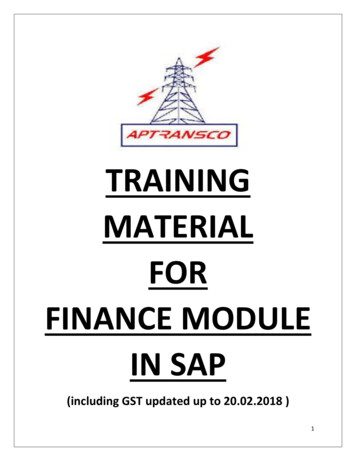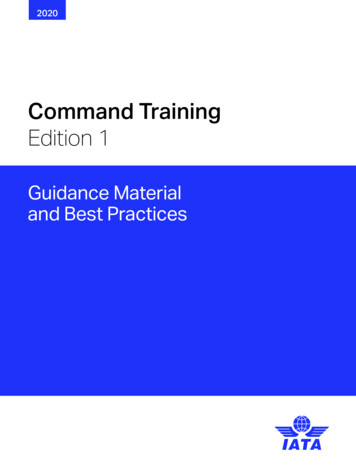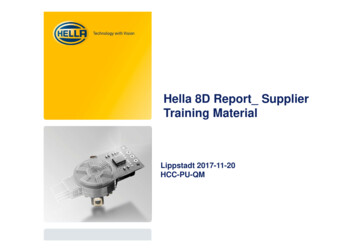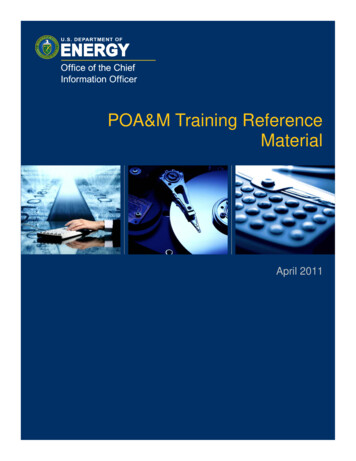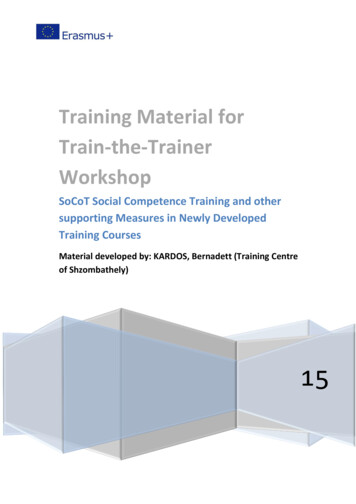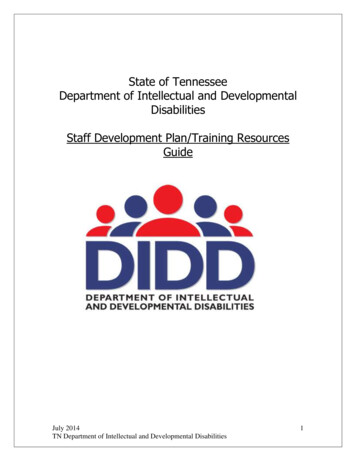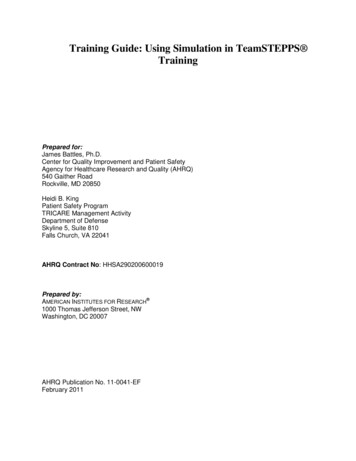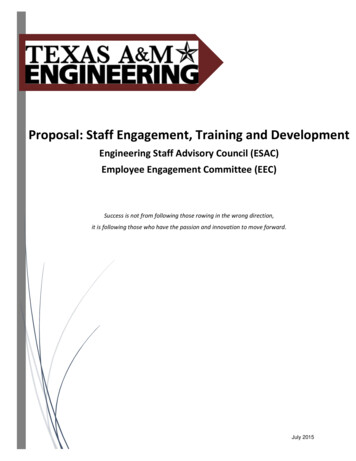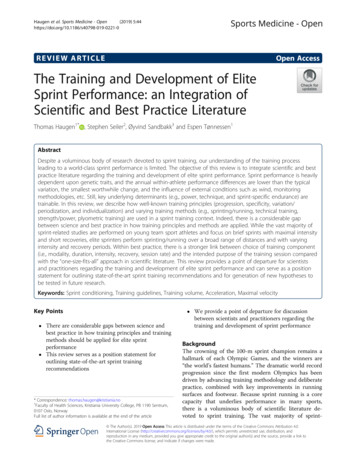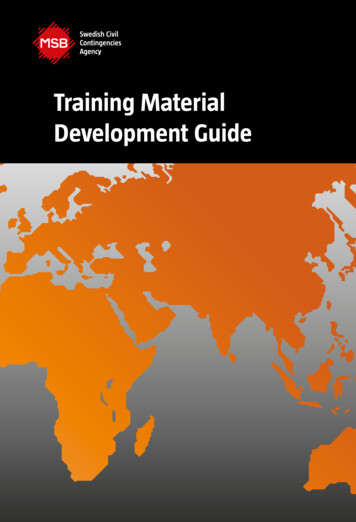
Transcription
Training MaterialDevelopment Guide
Developing TrainingMaterial GuideSwedish Civil Contingencies Agency (MSB)Dr Mo Hamza
Developing Training Material GuideSwedish Civil Contingencies Agency (MSB)Coordination and Operations departementContact person:Marielle PetterssonLayout: Advant Produktionsbyrå ABPrinting: DanagårdLiTHOOrder No. MSB507 - December 2012ISBN 978-91-7383-303-5
Table of contentAcknowledgment. . . . . . . . . . . . . . . . . . . . . . . . . . . . . . . . . . . . . . . . . . . . . . . . . . . . . . . . 5Preface and Purpose of the Guide. . . . . . . . . . . . . . . . . . . . . . . . . . . . . . . . . . . . . . . . . . . . . . . . . . . . . . . . 61. Coordination. . . . . . . . . . . . . . . . . . . . . . . . . . . . . . . . . . . . . . . . . . . . . . . . . . . . . . . . 91.1 Pre-Training Planning. . . . . . . . . . . . . . . . . . . . . . . . . . . . . . . . . . . . . . . . . . . . . . . . . . . . . . . . 91.2 Training Logistics Checklist. . . . . . . . . . . . . . . . . . . . . . . . . . . . . . . . . . . . . . . . . . . . . . . . . . . . . . . 102. Needs Assessment. . . . . . . . . . . . . . . . . . . . . . . . . . . . . . . . . . . . . . . . . . . . . . . . . . . . . . 132.1 Assessing Needs. . . . . . . . . . . . . . . . . . . . . . . . . . . . . . . . . . . . . . . . . . . . . . . . . . . . . . . 132.2 Adult Learners. . . . . . . . . . . . . . . . . . . . . . . . . . . . . . . . . . . . . . . . . . . . . . . . . . . . . . . 153. Design. . . . . . . . . . . . . . . . . . . . . . . . . . . . . . . . . . . . . . . . . . . . . . . . . . . . . . . 213.1 Course Design Process. . . . . . . . . . . . . . . . . . . . . . . . . . . . . . . . . . . . . . . . . . . . . . . . . . . . . . 223.2 Learning Outcomes. . . . . . . . . . . . . . . . . . . . . . . . . . . . . . . . . . . . . . . . . . . . . . . . . . . . . . 234. Development. . . . . . . . . . . . . . . . . . . . . . . . . . . . . . . . . . . . . . . . . . . . . . . . . . . . . 294.1 Developing Material. . . . . . . . . . . . . . . . . . . . . . . . . . . . . . . . . . . . . . . . . . . . . . . . . . . . . . . 294.2 Developing Presentations. . . . . . . . . . . . . . . . . . . . . . . . . . . . . . . . . . . . . . . . . . . . . . . . . . . . . . 365. Delivery. . . . . . . . . . . . . . . . . . . . . . . . . . . . . . . . . . . . . . . . . . . . . . . . . . . . . . 395.1 Training Methods. . . . . . . . . . . . . . . . . . . . . . . . . . . . . . . . . . . . . . . . . . . . . . . . . . . . . . . 395.2 Effective Communication Skills. . . . . . . . . . . . . . . . . . . . . . . . . . . . . . . . . . . . . . . . . . . . . . . . . . . . . . . 456. Evaluation. . . . . . . . . . . . . . . . . . . . . . . . . . . . . . . . . . . . . . . . . . . . . . . . . . . . . . 496.1 Forms of Evaluation. . . . . . . . . . . . . . . . . . . . . . . . . . . . . . . . . . . . . . . . . . . . . . . . . . . . . 496.2 Process Evaluation. . . . . . . . . . . . . . . . . . . . . . . . . . . . . . . . . . . . . . . . . . . . . . . . . . . . . . 52References. . . . . . . . . . . . . . . . . . . . . . . . . . . . . . . . . . . . . . . . . . . . . . . . . . . . . . . 57Note about the author. . . . . . . . . . . . . . . . . . . . . . . . . . . . . . . . . . . . . . . . . . . . . . . . . . . . . . 59
AcknowledgmentThis guide is an adaptation of a more specific Training MaterialDevelopment Guide that was developed for the Disaster Preparedness and Prevention Initiative Project in South Eastern Europe(DPPI-SEE). The development of the earlier and original guideowes a great deal of gratitude to a number of key individuals.I would like to acknowledge the work of the following individualswhose valuable comments and feedback were indispensable,namely Michael Meier, Maja Herstad, Marielle Pettersson, PetreVlad, Cvetka Krajic, Katja Banovec, Igor Milic, Damir Cemerinand Trajko Todorcevski.
Preface and Purpose of the GuideThis guide is designed to document the process and good practicein developing training material, piloting and testing it. The guideis aimed to help you (the course organiser) to plan and conductthe course. The guide includes information on the main stepsand stages in sequence of designing a training course all the wayto evaluation for feedback into further development.It is worth mentioning here that the design and developmentprocess of training material is anything but linear. It’s veryiterative but it’s a challenge and a difficulty to capture this in adocument such as this guide. Throughout the process it’s importantto remember that stage evaluation is paramount and going backfor modification maintains the integrity and relevance of thematerial.Design processes are always divided into steps and phases inorder to make sure that checks and tests are carried out at theappropriate time to avoid any lengthy and costly time consumingmodifications at the end.There are 4 key overarching principles to any design process –the 4Cs:1. Clarity: Working groups and design teams need to take theirtime at the onset of any course design process to achieve andagree clarity on several issues including: Purpose of the course,target group, aims and objectives, learning outcomes, processplan, responsibilities, piloting and testing, evaluation, etc. Themore this is given time and attention the better and smootherthe process that follows will run. If there is any disagreementon the fundamentals, it is going to affect almost every aspect ofthe design and development process and will be a constant insurmountable obstacle. It’s also important not to leave anythingto assumptions of any kind.
2. Capacity: Assessing the required capacity of the design anddevelopment team, those who will be involved in the administration and logistics of piloting and running the courses andthe overall management team is also fundamental. Trainingcourses are different and each requires a set of skills andexpertise unique from another depending on the context itruns in. Making sure that the right team is put together andgiven adequate resources is another fundamental principle intraining design and development. Time should also be taken inassembling the appropriate capacity package whether humanresources and expertise or material and non-tangible.3. Consistency: Consistency of approach once agreed upon maintains the quality of the design process. Once there is clarityon aims and objectives and the design team moves into thedetails of methods and training approach and techniques, it’simportant to stay consistent with what the training is tryingto achieve and stay focused on the main purpose. Design anddevelopment processes get derailed by losing focus or trying tofollow fads and gimmicks in training that might not be suitableto the purpose of the course. It’s also important that the designteam sticks with the process from beginning to end. If teammembers have to be substituted, it’s important that there isenough overlap/hand over period so new members can join in,bringing in fresh and new ideas without disrupting an on-goingprocess especially when it’s farther down the line.4. Commitment: This is largely what makes or breaks any design anddevelopment process. Commitment not just of the design teambut of all stakeholders involved in terms of supporting the designteam efforts financially, administratively, logistically, etc. Thebest design efforts falter and cannot be sustained when there islack of commitment.
Coordination
Coordination 111. CoordinationCoordinating a training course requires a variety of steps, tasks,and skills. Although a lot of training coordination takes placeduring the design phase, coordination is very important duringall phases of the training process. Coordination begins at thetime training is proposed and continues even after it is deliveredand participants leave.The various ”hats” a training coordinator wears include communication manager, materials producer, problem-solver, and evenentertainment director. In short, coordinating training requiresendless management of many details and people. This sectioncovers pre-training planning and checklists to be taken into accountearly on in the process.1.1 Pre-Training PlanningOne of the first and most important steps in pre-training planningis to identify and agree on roles and responsibilities before postsare even filled. Terms of reference should also be drawn for thefollowing set of roles:MANAGEMENTMATERIALS DEVELOPMENTTRAINING Programme Manager Curriculum Developer Training Coordinator Content Specialist Training Facilitators Training Co-Facilitators Administrative Assistant Curriculum Writer Curriculum Editor Graphic DesignerFor clarity of responsibilities the Programme Manager is usuallyand typically the MSB Programme Officer and in a case of a projectthat has a strong training component MSB’s Programme Officeris also the Programme Manager. The Training Coordinator, on theother hand, could be someone in the counter-part agency or theorganisation targeted by the training and/or based in the country
12 DEVELOPING TRAINING MATERIAL GUIDEwhere the training is planned. These two are different from theLead Material Development Specialist (also known as CurriculumDeveloper), who in some cases could be a hired consultant. TheAdministrative Assistant is a self-explanatory term and someonewho reports to the Training Coordinator and is responsible forthe details of training admin and logistics.1.2 Training Logistics ChecklistThe following checklist will be referred to time and time againthroughout the design and development process. It’s importantto consider it as early as possible since some of the decisionsmade at this stage will have fundamental implications on thematerial design and content. Reflecting back on the iterative natureof the design process some of the information in the followingchecklist should come from the training needs assessment,which is covered in the following section.WHAT YOU NEEDTO KNOWTrainingschedule/structureOptimal number oftraining daysSpread of training overone or more weeksBest days of the weekBest time of the dayLength of each sessionWHERE TO FINDTHE ANSWERHOW TO FIND THEANSWER (STEPS)TEAM NOTES
Coordination 13TRAINING LOCATIONAccessComfort ComfortTraining facilityAccommodationSupplies on-siteFood and drinkADVERTISINGLead time for advertisingInformation for nomination andenrolmentDirect invitationsOther advertising ideasREGISTRATIONOnline or by emailBy postOther ways of registration
NeedsAssessment
Needs Assessment 152. Needs AssessmentThe following four central questions must be answered beforeyou begin designing a training course. Audience: Who is the target audience for a proposed training? Current roles: What do members of this target audiencepresently do in their roles? Knowledge gaps: What gaps exist between what these providersknow how to do, and what they need to know to carry out theirroles successfully? Outcome: Will training help fill this gap?These questions form the foundation of a training needs assessment.For example, a curriculum developer or trainer must first understand what civil defence, civil contingency or disaster managementpersonnel presently do in their jobs and how training could changethe nature of their work. As a result, they will be better able todetermine what knowledge and skills needed. However, it is important to keep in mind that training is only part of a solution to meetprofessional needs identified in needs assessment. Other changes- in addition to training - may be needed in order to completely fill alearning gap.In addition, adult learners’ particular learning needs are importantconsiderations when designing training. Understanding thoseneeds is part of the needs assessment phase.2.1 Assessing NeedsThe first step in building a training course is identifying the needsof target participants. There is a variety of methods for conductinga needs assessment. An in-depth Key Informant Survey can also beused to provide further details and insights into needs and overallcourse design approach and material focus.A Need: A “need” refers to the gap between what is and what couldor should be within a particular context, leading to strategies aimedat eliminating the gap between what is and should or could be.
16 DEVELOPING TRAINING MATERIAL GUIDENeeds Assessment: Program-based needs assessment is:a. A systematic inquiry for the purposes of identifying prioritiesand making decisions, andb. Allocating finite resources in a manner consistent with identified program goals and objectives. Needs assessment includes: Identifying and analysing expressed and unexpressed needs. A plan to develop strategies that address such needs.The following key questions need to be posed in any needsassessment: What do the participants need to know and do as a result ofthis training? What do we need to know about the course participants andthe population they serve?Key tasks in any needs assessment will include, but not limitedto, the following:Determine the target population Identify what type of professionals the course isdesigned for.Determine the participants’ needs1 Draw from your past experience with similar groups Gather information from informal discussions amongprofessionals in the network Conduct surveys Conduct focus groups Work with an advisory panel Observe participants Interview participants Learn about critical incidents Determine what emerging data should be distributed1See for example: www.e-trainingmanuals.com.au nt/needs.html
Needs Assessment 17Understand the participants’ characteristics Experience Cultural background Education Location Mind set/Motivation Constraints (location, job demands, etc.)2.2 Adult LearnersIt is radically different to design training courses and materialfor adults than any other group. Adult learning follows certainprinciples listed below and adapted from: Malcolm S. Knowles,Elwood E. Holton III, & Richard A. Swanson, (2005) The AdultLearner: The Definitive Classic in Adult Education and Human ResourceDevelopment, Burlington, MA: Elsevier.1. Adults are often concerned that participating in a group willmake them look weak, either professionally or personally. Design training workshops, educational exercises, and discussion sessions that help people feel safe enough to askquestions and confident that they will be respected. Don’t ask people to take risks too early in a workshopor course (for example, engaging in a role play exercise)unless they already know each other well. Provide opportunities and allow time for people to establishthemselves in the group.2. Adults bring a great deal of experience and knowledge to anylearning situation. Show respect for participants’ experience by asking themto share ideas, opinions, and knowledge. Verbally recognisethat they may be a good resource for reaching your teaching goals. A needs assessment can tell you more about the individualsin the group. Or, if you already know the participants, youmay realise that particular individuals can provide helpfulinput before, during, or after your session(s) - see point 5below.
18 DEVELOPING TRAINING MATERIAL GUIDE3. Adults are decision-makers and self-directed learners. Do not seek to make people obey you. Adults will do whatthey need to do. Be the “guide on the side” rather than the “sage on thestage”. Listen to what they want and need and be flexible in yourplanning. Seek feedback from the group. Change yourapproach if your agenda or methods are not working.4. Adults are motivated by information or tasks that they findmeaningful. Conduct some type of needs assessment so that you areaware of what people want (and need) to learn, how muchthey already know, and the kinds of “generative themes”that might affect their attention span. Generative themes are concerns/issues that are most important in a person’s life. Generative themes may enhance or challenge a person’sability to learn. They could include such things as the fear of losing a job,the health of a loved one, the desire for a promotion, theneed for a change, the pending birth of a child, problemsin a relationship, or new possibilities for growth anddevelopment.5. Adults have many responsibilities and can be impatient whentheir time is wasted. Be thoughtful and kind. Begin and end your session on time. Understand who is in the audience and why they are participating. Learn what questions they have about the subject. Don’t cover material they already know unless there is agood reason for it. Recognise that your subject is only one of many that participants may be interested in learning more about.The following are more specific tips and style in adult learning:
Needs Assessment 19ADULTS LEARN BEST WHENMATCHING ADULT LEARNING NEEDS WITHAPPROPRIATE METHODSThey feel valued and respected for the experiencesand perspectives they bring to the training situation.Elicit participants’ experiences and perspectivesthrough a variety of stimulating activities.The learning experience is active rather thanpassive.Actively engage participants in their learningexperience through discussion and a variety ofactivities.The learning experience actually fills their immediate needs.Identify participants’ needs; develop training concepts and learning objectives to these identifiedneeds.They accept responsibility for their own learning.Make sure that training content and skills aredirectly relevant to participants’ experiences sothat they will want to learn.Their learning is self directed and meaningful tothemInvolve participants in deciding on the content andskills that will be covered during the training.Their learning experience addresses ideas, feelings,and actions.Use multiple training methods that address knowledge, attitudes, and skills.New material relates to what participants alreadyknowUse training methods that enable participants toestablish this relationship and integrate new materialThe learning environment is conducive to learning.Take measures to ensure that the physical andsocial environment (training space) is safe, comfortable, and enjoyableLearning is applied immediately.Provide opportunities for participants to apply thenew information and skills they have learned.Learning is reinforced.Use training methods that allow participants topractice new skills and receive prompt, reinforcingfeedback.Learning occurs in small groups.Use training methods that encourage participantsto explore feelings, attitudes, and skills with otherlearners.The trainer values participants’ contributions asboth learners and teachers.Encourage participants to share their expertise andexperiences with others in the training.
20 DEVELOPING TRAINING MATERIAL GUIDELEARNING STYLESCONSIDER USINGLearn best with abstract concepts and lecturesCase studies and discussions about theories andresearchLearn best while observing othersDemonstrations and videosLearn best from exercisesRole playing and other experiential activitiesLearn best through visual meansVideos, images, and slidesIt is also important to recognise that people learn differently andthat there are several learning styles. Training courses that recognise different types of learners and caters for their needs succeeda lot more in achieving their objectives than the ones that try tofunnel all participants through a rigid narrow way of single oruni-learning mode.Generally there are four modes of learning and people could beone or another or even switch between different modes dependingon the subject matter: Doer: Likes to be actively involved in the learning process,wants to know how he or she will apply learning in the realworld, likes information presented clearly and concisely. Feeler: People-oriented, expressive, focuses on feelings andemotions, thrives in open, unstructured learning environment. Thinker: Relies on logic and reason, likes to share ideas andconcepts, analyses and evaluates, enjoys independent work. Observer: Likes to watch and listen, tends to be reserved, willtake his or her time before participating, and thrives on learningthrough discovery.
Training within the West Africa Disaster ManagementCapacity Building project.Photo: MSB
Design
Design 233. DesignDesigning a training course is like mapping out a road trip orcreating a journey. A training design is basically an outline of allthe ”what, where, who, when and how” details of the training foruse by coordinators, curriculum developers, and trainers. Thereare five primary components of a training design: Learning Outcomes: What will participants be able to do as aresult of completing the training? Training Materials: What materials need to be developed andwhat will the materials include? Trainers and Content Experts: Who will facilitate the trainingand act as content experts to review materials? Training Methods: What methods will be used so that participants meet the learning objectives and learn the content mosteffectively? Logistics: Where and when will the training take place? Whowill be invited and how will they be notified? Will a per diembe paid to participants? Etc.Optimally, the results of a needs assessment inform these fivetraining design components. For example, if we know the gapbetween what a target audience knows and what it needs to know,we can write learning outcome statements that precisely meettheir job-related needs. Needs assessment will also help determinewho will be needed as content experts for the training, and whethera course should be one, three, or five days long.
24 DEVELOPING TRAINING MATERIAL GUIDE3.1 Course Design ProcessCourse design refers to the planning and structuring of a courseto achieve specific instructional goals. The course design processincludes the following activities: Identifying appropriate goals Choosing content that’s consistent with the goals Selecting ways to achieve the goals Assessing participant learning in relation to the goalsAs part of the design process, instructors should also consider: Their own teaching style The learning styles of the participants The role of the course in the overall training effortBefore training beginsMost design decisions must be made before the first session ofthe course. These decisions relate to these basic areas: The content to include The delivery methods to use The time allocated for each of the goals The tools for assessing participant learningDuring the training sessionAs you conduct the training, we will learn more about the participants and their needs. This information may require adjustments in the course design. For example, after working with thegroup, we may decide to: Change the time allocation for a particular topic Change the type of activity associated with a particular topic,for instance, from an individual to a group activity or vice versaAt the conclusion of the sessionThe information we gather at the conclusion of a training sessionwill help us assess the effectiveness of the current training andhelp improve future training sessions. To evaluate the course: Use appropriate evaluation tools and our own perceptions
Design 25Going into further detail of curriculum design the followingchecklist and questions are used as guidance:Complete this training worksheet to help you begin designingyour training.1. General theme or topic: In general, what knowledge and skillareas will be the focus of the training?2. Goals and objectives: What do we want participants to learnduring the training? (What will they leave knowing moreabout or what new skills will they have acquired?)3. Essential questions: What central questions do we want participants answering as the training unfolds?4. Summary of participant activities: How will participantsaccomplish curriculum objectives and answer the questionsin numbers 2 and 3 above? (e.g. small group discussions andprojects, lectures, role-playing.)5. Resources: What resources might the trainer use to helpparticipants accomplish curriculum objectives? (e.g. currentresearch, guest speakers, discussions, encouragement)6. Assessment activities: How will we determine if participantsa) have reached curriculum objectives identified in number 2above; and b) can answer the questions in number 3.7. Evaluation of the training and the training process: How willwe evaluate the quality and usefulness of the training as wellas its implementation?3.2 Learning OutcomesLearning objectives are central to designing a training course.They must reflect the needs assessment results and work inharmony with training methods and design. A learning outcomeis a statement of what a learner is expected to know, understand,or be able to do as a result of a learning process. There are severalways of developing appropriate learning outcomes/objectives.Beginning a learning objective with a strong verb can help guidethe development of training because it focuses attention on whatparticipants are supposed to be able to DO after they completetraining.
26 DEVELOPING TRAINING MATERIAL GUIDEThe following are just a few examples of standard verbs used tostart a learning outcome or objective eInterpretPracticeShow sensitivityAccept responsibilityBe willing to assistRespect opinionsDemonstrate commitmentThere are specific reasons why learning outcomes and objectivesshould be well thought through and clearly stated from the outsetand before any design activities take place. These are: Identifying outcomes is an effective way to review curriculumand content. This leads to a more balanced and well-sequencedcurriculum. It helps design appropriate assessment and evaluation toolsthat accurately reflect the curriculum. By reviewing the needs assessment, trainers know what participants know and need, and the learning outcomes help informeveryone as to what new materials or skills they are intendedto learn. Trainers are able to evaluate the effectiveness of their teaching.Have the outcomes been achieved? An instructional shift from teaching to learning is facilitated.The focus is on the learner rather than the trainer. Participants will know exactly what they are expected to learn,thus avoiding ambiguity. If you build participant learning assessments into the training,participants will know exactly how their learning will beassessed.
Design 27 Participants begin to take more responsibility for their ownlearning when they know what they are expected to do andwhat standard they are expected to achieve.At the stage of writing learning outcomes and objectives, thefollowing questions need to be considered: What information or content do we want participants to learnfrom the training? What do we want them to do with that information? What skills or competencies do we want them to gain, develop,expand, or improve? What kind of higher-level thinking do we want them toengage in? How do we expect participants to demonstrate what they havelearned and how well they have learned it? At the very minimum, what should participants know and beable to do when they finish the training? How do we think they will be able to use the information andskills that they develop? If someone asks the participants what they learned from yourtraining, how would we like them to answer?There are four major steps to any training design process:STEP 1:It is much better to sketch out the whole curriculum before goinginto the specifics. Think about the big picture: What is the major aim of the training? What is it trying to achieve?WRITE a goal or aim statement. This should be a broad, generalstatement, such as; participants will be able to understand theimportance of disaster risk reduction along side preparednessand response.
28 DEVELOPING TRAINING MATERIAL GUIDESTEP 2:CONSIDER the overall scope of training.Specify the major topics or sections of the training by brainstorming (with others) and making a list. What sort of things do we want the participants to learn?At this level the outcome statements will be quite broad referringto such areas that cover the whole subject.For example: It is anticipated that participants who successfullycomplete the training will be able to:1. Establish a common understanding of the tenets on which liethe foundations of disaster risk reduction (DRR).2. Develop a better understanding of preparedness, response andrecovery as integral to disaster risk reduction.3. Illustrate the role of different stakeholders in DRR, the integrated nature between the sectors in DRR and the importance ofcoordination between stakeholders.4. Introduce and discuss the already put in place mechanisms forreducing disaster losses and risk management, focused on theirregion.5. Build a network among the participants by sharing the experience, existing know-how and team building.STEP 3:The next step is to IDENTIFY specifics. Brainstorm and create alist. This is where we will write clear, precise statements detailingwhat the participants will actually be doing. What specific, detailed knowledge, information, or skills do weexpect participants to learn from the training? What cro
12 DEVELOPING TRAINING MATERIAL GUIDE where the training is planned. These two are different from the Lead Material Development Specialist (also known as Curriculum Developer), who in some cases could be a hired consultant. The Administrative Assistant is a self-explanatory term and someone who report
